Welcome to the comprehensive guide for Safety 1st gate instructions. This manual provides detailed steps for installing‚ maintaining‚ and troubleshooting your Safety 1st gate‚ ensuring a secure setup for your home. Proper installation is crucial for safety‚ and this guide will walk you through every step to guarantee a reliable and durable babyproofing solution. Learn how to adjust extendable panels‚ use the easy-close functionality‚ and maintain your gate for long-term performance. With clear instructions and safety tips‚ you can confidently protect your family with a correctly installed Safety 1st gate.
1.1 Overview of Safety 1st Gates
Safety 1st gates are designed to provide reliable safety solutions for homes‚ offering durability and ease of use. These gates are available in various models‚ such as the Easy Close Metal Gate and the Flat Step Stair Gate‚ catering to different safety needs. They feature extendable panels‚ making them adaptable to diverse doorway and stairway openings. With a focus on user-friendly design‚ Safety 1st gates ensure secure babyproofing while maintaining a sleek appearance. Their innovative features‚ like flat thresholds and easy-close mechanisms‚ enhance functionality and convenience for parents.
Each gate model comes with detailed manuals‚ providing clear instructions for installation‚ maintenance‚ and troubleshooting. By following these guidelines‚ users can ensure optimal performance and safety. Safety 1st gates are trusted for their quality and effectiveness in protecting children from potential hazards at home.
1.2 Importance of Proper Installation
Proper installation of Safety 1st gates is essential to ensure maximum safety and functionality; Incorrectly installed gates may leave gaps or fail to secure openings‚ posing risks to children. Following the manual’s step-by-step instructions guarantees a secure setup‚ preventing potential hazards such as accidental falls or injuries. A well-installed gate minimizes risks and provides peace of mind for parents. Regular checks and adherence to safety guidelines further enhance the gate’s performance and durability.
Refer to the Safety 1st gate manual for specific installation requirements and troubleshooting tips to ensure your gate operates effectively and safely over time.

Key Features of Safety 1st Gates
Safety 1st gates offer innovative features like extendable panels‚ easy-close functionality‚ and flat step designs for enhanced safety and convenience. These features ensure secure and adaptable babyproofing solutions.
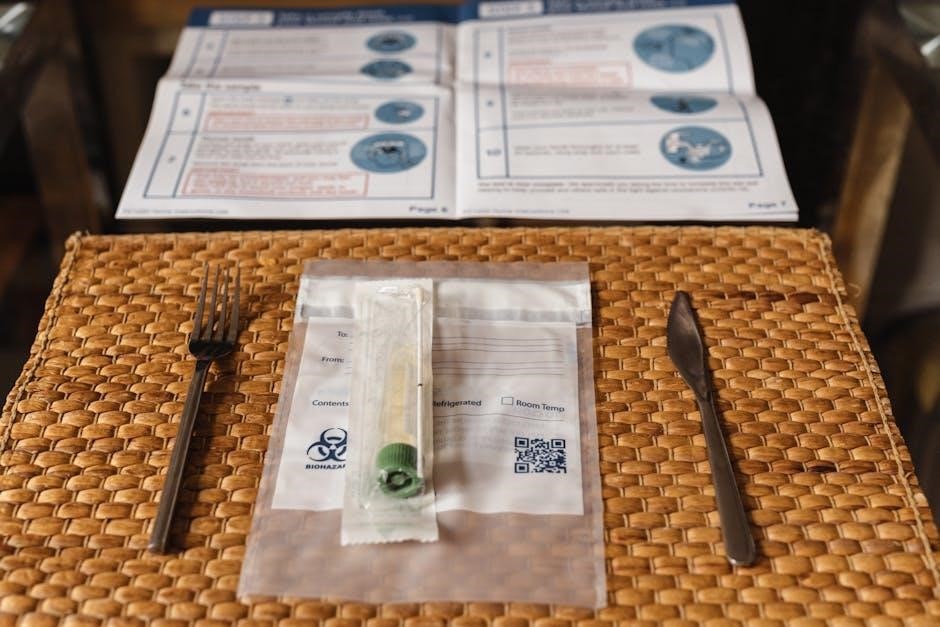
2.1 Adjustability and Extendable Panels
Safety 1st gates are designed with adjustability and extendable panels to accommodate various doorway and hallway widths. This feature ensures a secure fit‚ adapting to different spaces effortlessly. The extendable panels allow for customization‚ making the gate suitable for diverse home layouts. Users can easily adjust the width to ensure proper alignment and stability. This adaptability is a key advantage‚ providing a reliable safety solution without compromising on convenience. The extendable design also allows the gate to grow with the family’s needs‚ offering long-term usability and flexibility.
2.2 Easy Close Metal Gate Functionality
The Easy Close Metal Gate by Safety 1st offers a smooth‚ one-handed closing mechanism‚ ensuring convenience and ease of use. Its advanced functionality includes an automatic shut feature‚ which securely closes the gate when not in use. This design prevents accidental openings and enhances safety‚ especially around children. The gate’s metal construction provides durability and stability‚ while its sleek design blends seamlessly with home decor. The Easy Close feature is both practical and efficient‚ making it ideal for busy households seeking reliable babyproofing solutions without compromising on functionality or style.
2.3 Flat Step Stair Gate Innovation
The Safety 1st Flat Step Stair Gate introduces a revolutionary design tailored for stairs‚ featuring a flat threshold that eliminates tripping hazards. This innovation ensures smooth transition over the gate‚ while maintaining robust safety standards. Designed for seamless integration with staircases‚ the gate’s mechanism allows for easy one-handed operation‚ perfect for parents carrying children or items. The Flat Step technology enhances both functionality and safety‚ making it an essential feature for households with stairs. Its durable construction and adaptive design ensure long-lasting performance and peace of mind for families.
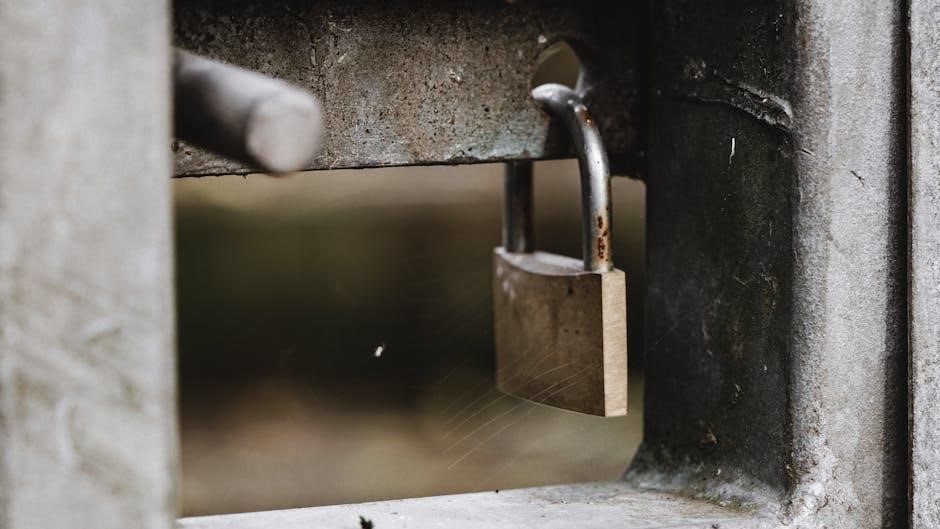
Pre-Installation Checklist
Ensure a smooth installation by gathering tools‚ measuring openings‚ and verifying gate specifications. Plan the layout and confirm all components are undamaged and accounted for.
3.1 Measuring the Opening
Accurate measurements are crucial for a proper fit. Use a tape measure to determine the width of the doorway or stairway. Note any obstructions like baseboards or moldings. Ensure the gate’s adjustable range matches the opening size. Measure at the narrowest and widest points to confirm compatibility. Double-check the measurements to avoid errors. If the opening is uneven‚ consider using optional extensions or spacers. Refer to the product manual for specific size requirements. Precise measuring ensures the gate will function smoothly and securely‚ preventing gaps or misalignment during installation.

3.2 Gathering Required Tools
To ensure a smooth installation‚ gather all necessary tools beforehand. A tape measure is essential for accurate adjustments. You’ll also need a screwdriver (both Phillips and flathead) for assembling and securing components. A drill may be required for mounting hardware into walls. Additionally‚ a level will help ensure the gate is properly aligned. Some installations might need an Allen wrench or wrench for tightening specific parts. Check the gate’s hardware kit for included items and refer to the manual for any tool specifications. Having all tools ready saves time and ensures a hassle-free setup process for your Safety 1st Gate.
3.3 Understanding Gate Specifications
Understanding the specifications of your Safety 1st Gate is crucial for proper installation and functionality. Review the product manual to familiarize yourself with the gate’s dimensions‚ weight capacity‚ and material composition. Note the maximum and minimum width the gate can accommodate‚ as this ensures it fits your desired opening. Check for any specific features like one-hand operation or auto-close functions; Knowing these details helps you determine if additional accessories are needed. Always verify that the gate meets safety standards for your intended use‚ such as stair safety or pet containment. This step ensures a safe and secure setup tailored to your needs.
Step-by-Step Installation Guide
This section provides a detailed‚ step-by-step guide to installing your Safety 1st Gate. Follow each instruction carefully‚ starting with unpacking components‚ attaching hardware‚ adjusting width‚ and securing the gate. Refer to your product manual for model-specific instructions.
4.1 Unpacking and Preparing Components
Begin by carefully unpacking the Safety 1st Gate and its accessories. Verify all components are included‚ such as gate panels‚ hardware‚ brackets‚ and screws. Lay out the parts on a flat‚ protective surface to avoid damage. Remove any protective packaging and organize the pieces for easy access. Double-check the product manual to ensure no items are missing or damaged. This step ensures a smooth installation process and helps prevent delays. Organizing components categorically‚ like hardware and panels‚ will make assembly more efficient. Always refer to the manual for specific unpacking instructions tailored to your gate model.

4.2 Attaching Hardware and Brackets
Start by identifying the hardware and brackets from the unpacked components. Use a screwdriver to attach the mounting brackets to the gate panels‚ ensuring they align securely. Follow the manual’s guidance for specific bracket placement‚ as this varies by gate model. Tighten screws firmly but avoid over-tightening‚ which could damage the material. Next‚ attach the hinge and latch mechanisms to the corresponding panels‚ ensuring proper alignment for smooth operation. Double-check all connections for stability before proceeding to the next step. Properly secured hardware is essential for the gate’s functionality and safety.
4.3 Adjusting Gate Width
To adjust the gate width‚ locate the expansion points or adjustment mechanisms on the gate panels. For most Safety 1st gates‚ this involves sliding the telescoping sections or loosening the locking mechanism. Use a measuring tape to ensure the gate fits the opening precisely. Slide the panels outward or inward until the desired width is achieved‚ then re-tighten the locking devices firmly. Double-check the alignment and stability by gently shaking the gate. Proper adjustment ensures a secure fit and prevents gaps that could pose safety risks. Always refer to the manual for model-specific adjustment instructions.
4.4 Securing the Gate
After adjusting the gate width‚ secure it by tightening all brackets and hardware firmly. Ensure the gate is level and aligned properly with the floor or surface. Double-check that all screws and bolts are tightened to prevent any shifting. Test the gate’s stability by gently pushing or pulling it to confirm it holds firmly in place. Make sure the latch or locking mechanism is functioning correctly and cannot be easily opened by children. Finally‚ verify that the gate is secure at both the top and bottom to prevent any movement or tipping‚ ensuring maximum safety and reliability.
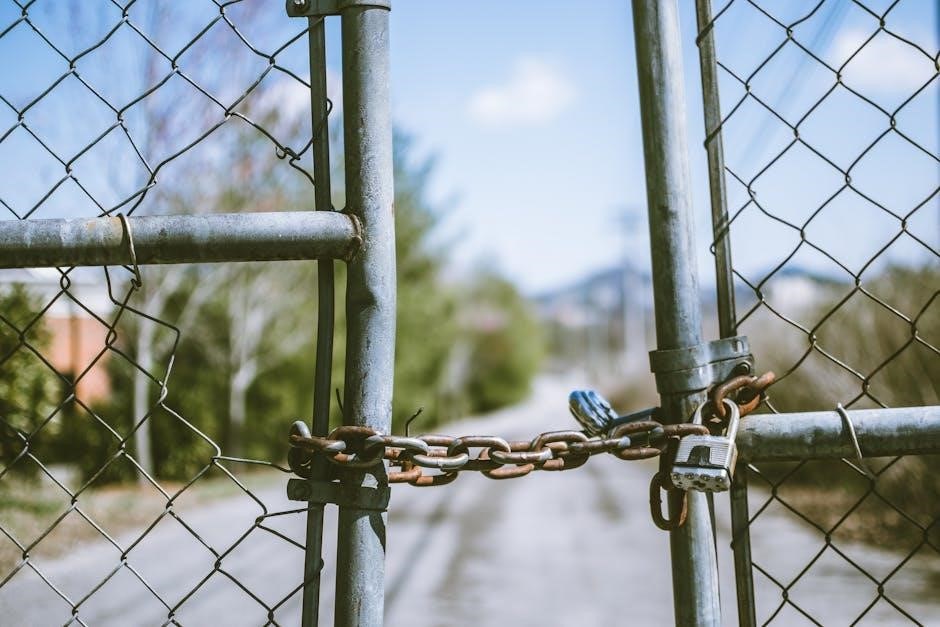
Maintenance and Upkeep
Regular maintenance ensures your Safety 1st gate remains functional and secure. Clean the gate with a damp cloth‚ lubricate hinges‚ and inspect for wear or damage. Always tighten loose screws and replace worn parts promptly to maintain stability and safety.
5.1 Regular Cleaning
Regular cleaning is essential to maintain the functionality and appearance of your Safety 1st gate. Use a soft cloth and mild detergent to wipe down the frame‚ hinges‚ and hardware. Avoid harsh chemicals or abrasive cleaners‚ as they may damage the finish or compromise safety features. Pay special attention to areas where dirt and grime accumulate‚ such as the bottom rail and locking mechanism. Dry the gate thoroughly after cleaning to prevent moisture buildup. Cleaning every 1-2 weeks‚ or as needed‚ ensures optimal performance and longevity of the gate.
5.2 Lubricating Moving Parts
Lubricating the moving parts of your Safety 1st gate ensures smooth operation and prevents squeaking. Use a silicone-based spray or grease on hinges and the Hush Bolt system. Avoid oil or petroleum-based products‚ as they can attract dirt. Clean the area first to remove grime. Apply lubricant directly to moving components‚ then open and close the gate several times to distribute evenly. Wipe off excess lubricant to avoid dust accumulation. Regular lubrication every 2-3 months maintains functionality and extends the gate’s lifespan.
5.3 Checking Stability
Regularly checking the stability of your Safety 1st gate is essential for maintaining safety and functionality. Inspect the hardware to ensure all screws and brackets are tightly secured. Verify that the gate is level and properly aligned with the floor or surface it’s installed on. If the gate feels loose or unstable‚ tighten the mounting hardware. For gates installed at the top of stairs‚ double-check that the floor is even and the gate is firmly anchored. Test the gate by gently applying pressure to ensure it doesn’t shift or wobble. Addressing any instability promptly helps prevent accidents and ensures reliable performance over time.
Troubleshooting Common Issues
Addressing common issues ensures your gate remains functional and safe. Check for loose hardware‚ misalignment‚ or obstructed closing mechanisms. Regularly inspect hinges and latches for wear. Correcting issues promptly prevents larger problems and ensures longevity. Always refer to the manual for specific solutions.
6.1 Gate Not Closing Properly
If the gate isn’t closing properly‚ check for obstructions like toys or uneven flooring. Ensure the gate is correctly aligned with the latch. Verify the latch mechanism is clean and free of debris. Adjust the gate’s position slightly if it’s misaligned. Tighten any loose hardware‚ as this can affect closure. Lubricate hinges if they’re stiff. If issues persist‚ consult the manual or contact customer support for assistance. Proper closure is essential for safety‚ so addressing this promptly is crucial.
6.2 Hardware Loosening Over Time
Hardware may loosen over time due to normal wear and tear. Regularly inspect all screws‚ bolts‚ and brackets. Tighten any loose components using the appropriate tools‚ like an Allen wrench or screwdriver. If hardware consistently loosens‚ consider applying a threadlocker for added stability. Ensure the gate is properly installed and aligned‚ as misalignment can cause excessive stress on the hardware. Addressing this issue promptly prevents the gate from becoming unstable and ensures ongoing safety. Refer to the manual for specific tightening recommendations if needed.
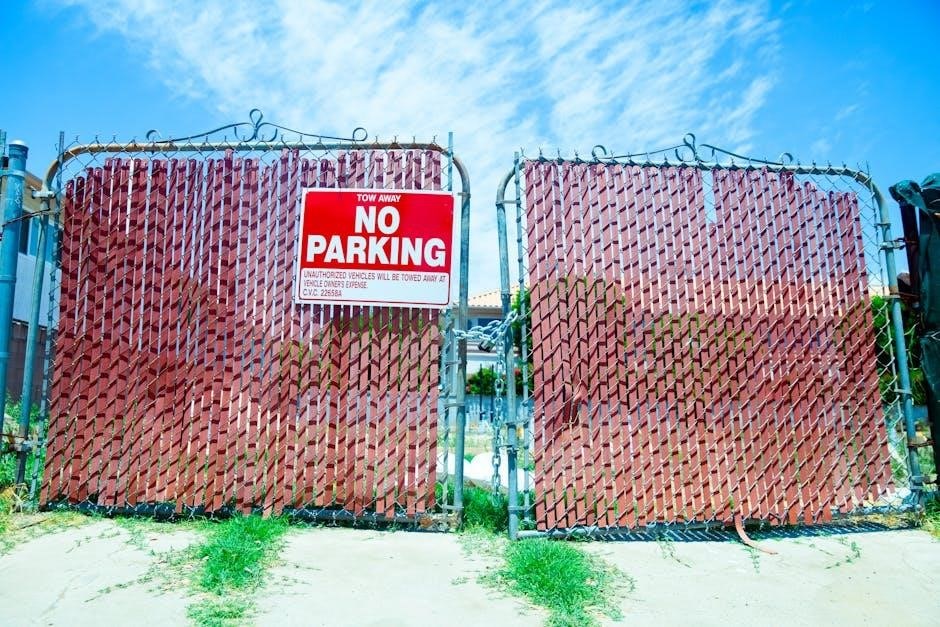
6.3 Adjusting Gate Alignment
Proper alignment is crucial for the gate to function smoothly. If the gate becomes misaligned‚ adjust the brackets or hinges. Loosen the screws slightly‚ then gently shift the gate into the correct position. Ensure the gate is level and evenly spaced. Tighten the screws firmly once aligned. If the gate still doesn’t align properly‚ check for obstructions or uneven surfaces. Use shims or adjust the mounting points as needed. Regular alignment checks prevent issues like improper closing or instability. Always refer to the manual for specific adjustment instructions tailored to your gate model.

Safety Precautions and Tips
Always ensure the gate is securely installed and closed when not in use. Regularly inspect for wear and tear‚ and keep children away during installation.
7;1 General Safety Guidelines
Always adhere to these guidelines to ensure child safety and prevent accidents. Supervise children when the gate is in use and read the manual thoroughly before installation. Regularly inspect the gate for damage or wear. Ensure proper installation and usage according to manufacturer instructions. Keep the gate closed and secure when not in use. Avoid climbing over the gate‚ as this can cause instability. Position the gate away from hazards like stairs or hot surfaces. By following these guidelines‚ you can help create a safer environment for your child.
7.2 Positioning the Gate Correctly
Correct positioning is crucial for optimal safety and functionality. Measure the area carefully to ensure proper fit and alignment. Avoid placing the gate near hazards‚ such as stairs or hot surfaces. Position it to prevent children from accessing dangerous areas while maintaining visibility. Ensure the gate is not too close to walls or furniture that could cause entrapment. Always follow the manufacturer’s recommendations for placement. By positioning the gate correctly‚ you create a safe barrier that protects your child without compromising convenience or visibility.
7.3 Ensuring the Gate is Secure
To ensure the gate remains secure‚ always tighten hardware according to the manufacturer’s instructions. Check that all brackets are firmly attached and properly aligned. Regularly inspect the gate for loose screws or worn parts and address them promptly. Test the gate’s stability by gently shaking it to confirm it holds firm. Use any additional safety features‚ such as locks or latches‚ as recommended. Keep in mind that a secure gate is only effective if used consistently and maintained over time. Always refer to the manual for specific tightening and adjustment guidelines.
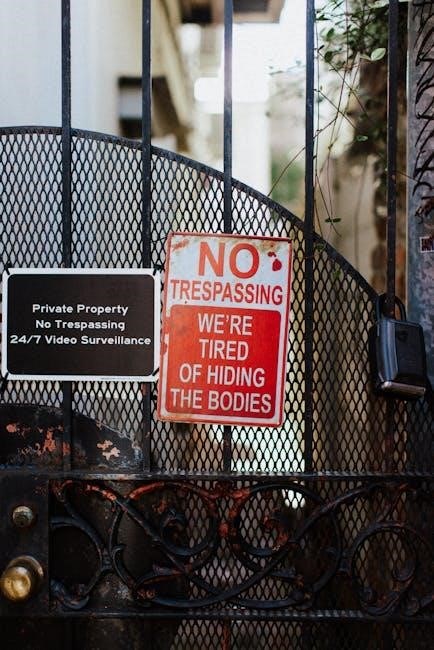
Accessing and Using Product Manuals
Access product manuals via the official website or provided CD. Understand instructions thoroughly for proper gate installation and maintenance. Use visual guides for clarity and ease.
8.1 Finding the Right Manual
To find the correct manual for your Safety 1st gate‚ visit the official Safety 1st website and navigate to the “Support” or “Downloads” section. Enter your gate model number or product name in the search bar for quick access. Manuals are often provided in PDF format for easy viewing and printing. If you purchased the gate in-store‚ check for a CD or printed manual included in the packaging. Ensure the manual matches your specific model to avoid confusion. Contact customer support if you cannot locate the manual online or need further assistance.
8.2 Understanding Manual Instructions
The Safety 1st gate manual is structured to guide users through installation‚ maintenance‚ and troubleshooting. It begins with an introduction to gate components and features‚ followed by detailed step-by-step instructions. Visual diagrams and illustrations are included to clarify complex steps. Safety precautions are highlighted to ensure proper use. The manual also covers troubleshooting common issues‚ providing solutions for problems like misalignment or hardware malfunctions. Pay attention to symbols and notes‚ as they emphasize critical steps or potential hazards. Reading the manual thoroughly before starting ensures a smooth and safe installation process.
8.3 Visual Guides and Diagrams
The Safety 1st gate manual includes detailed visual guides and diagrams to simplify the installation and maintenance process. These visuals provide clear step-by-step instructions‚ showcasing how to assemble and secure the gate properly. Color-coded components and labeled parts help users identify hardware and tools needed. Diagrams illustrate proper positioning‚ alignment‚ and adjustment techniques. Troubleshooting sections include visual examples of common issues and their solutions. These visual aids ensure users can follow instructions accurately‚ reducing the risk of errors and ensuring the gate functions safely and effectively. They are essential for both novice and experienced users.
Proper installation and maintenance ensure Safety 1st gates function safely and reliably. Always follow guidelines for secure setup and regular inspections to maintain gate performance and durability.
9.1 Summary of Key Points
Proper installation‚ regular maintenance‚ and adherence to safety guidelines are crucial for optimal functionality. Safety 1st gates offer adjustability and innovative features like the flat step design for convenience. Ensuring the gate is securely installed and regularly inspected helps prevent accidents. Tools like Allen keys and screws are essential for adjustments. Lubricating hinges and checking stability maintain performance. Troubleshooting common issues promptly‚ such as alignment or hardware tightening‚ ensures longevity. Always refer to product manuals for specific instructions. By following these steps‚ Safety 1st gates provide reliable protection and peace of mind for families.
9.2 Final Safety Reminders
Always ensure the gate is closed and securely latched when not in use to prevent accidents. Regularly inspect the gate for wear and tear‚ addressing any damage promptly. Keep the gate out of reach of children when open to avoid unintended closing. Ensure all users‚ especially caregivers‚ understand proper operation. Supervise children near the gate‚ even if it’s installed correctly. Familiarize yourself with the product manual for any specific safety recommendations. By adhering to these reminders‚ you can maintain a safe environment and prevent potential hazards‚ ensuring the gate functions as intended to protect your child.